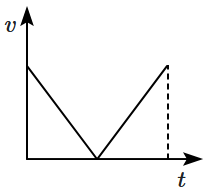Select Question Set:
A ball is thrown vertically upward with a certain velocity from the surface of the earth and after some time it returns back to the earth. The velocity-time (\(v\text-t\)) graph for the entire journey is given by:
| 1. |  |
2. |  |
| 3. |  |
4. |  |
Subtopic: Graphs |
58%
Level 3: 35%-60%
Please attempt this question first.
Hints
Please attempt this question first.
The relation between acceleration and time for an object is given by, \(a=2t+t^{2}.\) If the object starts from rest, then its velocity at \(t=1\) s, is: (\(a\) is in m/s2 and \(t\) is in seconds)
| 1. | \(\dfrac{5}{3}\) m/s | 2. | \(\dfrac{4}{3}\) m/s |
| 3. | \(2\) m/s | 4. | \(3\) m/s |
Subtopic: Acceleration |
76%
Level 2: 60%+
Please attempt this question first.
Hints
Please attempt this question first.
The numerical ratio of displacement to the distance covered is always:
| 1. | less than one |
| 2. | equal to one |
| 3. | equal to or less than one |
| 4. | equal to or greater than one |
Subtopic: Distance & Displacement |
83%
Level 1: 80%+
Please attempt this question first.
Hints
Please attempt this question first.
A car, which is initially stationary, accelerates for
\(5\) s at \(4.0\) m/s2 along a straight road. It then continues in the same direction for \(20\) s at a constant speed. What is the maximum speed of the car, and what is the distance travelled by the car in the final \(20\) s of its motion?
\(5\) s at \(4.0\) m/s2 along a straight road. It then continues in the same direction for \(20\) s at a constant speed. What is the maximum speed of the car, and what is the distance travelled by the car in the final \(20\) s of its motion?
| 1. | maximum speed = \(24\) m/s; distance = \(480\) m |
| 2. | maximum speed = \(20\) m/s; distance = \(400\) m |
| 3. | maximum speed = \(9.0\) m/s; distance = \(200\) m |
| 4. | maximum speed = \(9.0\) m/s; distance = \(180\) m |
Subtopic: Uniformly Accelerated Motion |
82%
Level 1: 80%+
Please attempt this question first.
Hints
Please attempt this question first.
A car travels a distance \(AB\) in three equal segments: the first third at a velocity of \(v_1~\text{m/s},\) the second third at \(v_2~\text{m/s},\) and the final third at \(v_3~\text{m/s}.\) Given that \(v_3 = 3v_1 , ~v_2 = 2v_1\) and \(v_1 = 11~\text{m/s} ,\) the average velocity of the car is:


| 1. | \(12~\text{m/s}\) | 2. | \(18~\text{m/s}\) |
| 3. | \(16~\text{m/s}\) | 4. | \(11~\text{m/s}\) |
Subtopic: Average Speed & Average Velocity |
76%
Level 2: 60%+
JEE
Please attempt this question first.
Hints
Please attempt this question first.
Given below are two statements:
| Assertion (A): | Two balls of different masses are thrown vertically upward with the same speed. They will pass through their point of projection in the downward direction with the same speed. |
| Reason (R): | The maximum height and downward velocity attained at the point of projection are independent of the mass of the ball. |
| 1. | Both (A) and (R) are True and (R) is the correct explanation of (A). |
| 2. | Both (A) and (R) are True but (R) is not the correct explanation of (A). |
| 3. | (A) is True but (R) is False. |
| 4. | Both (A) and (R) are False. |
Subtopic: Uniformly Accelerated Motion |
80%
Level 1: 80%+
Hints
Which of the following position-time \((x\text-t)\) graphs may be possible corresponding to given velocity-time \((v\text-t)\) graph?
| 1. |  |
2. |  |
| 3. |  |
4. |  |
Subtopic: Graphs |
69%
Level 2: 60%+
Please attempt this question first.
Hints
Please attempt this question first.
Given below are two statements:
| Assertion (A): | A body is momentarily at rest at the instant it reverses the direction. |
| Reason (R): | A body cannot have acceleration if its velocity is zero at a given instant of time. |
| 1. | Both (A) and (R) are True and (R) is the correct explanation of (A). |
| 2. | Both (A) and (R) are True but (R) is not the correct explanation of (A). |
| 3. | (A) is True but (R) is False. |
| 4. | (A) is False but (R) is True. |
Subtopic: Instantaneous Speed & Instantaneous Velocity |
67%
Level 2: 60%+
Please attempt this question first.
Hints
Please attempt this question first.
Mark the correct statements for a particle going on a straight line:
| (a) | if the velocity and acceleration have opposite sign, the object is slowing down. |
| (b) | if the position and velocity have opposite sign, the particle is moving towards the origin. |
| (c) | if the velocity is zero at an instant, the acceleration should also be zero at that instant. |
| (d) | if the velocity is zero for a time interval, the acceleration is zero at any instant within the time interval. |
Choose the correct option:
| 1. | (a), (b) and (c) | 2. | (a), (b) and (d) |
| 3. | (b), (c) and (d) | 4. | all of these |
Subtopic: Acceleration |
66%
Level 2: 60%+
Hints
A Cheetah can accelerate from \(0\) to \(96\) km/h in \(2\) s. What is the average acceleration of the Cheetah?
1. \(10\) m/s2
2. \(13.3\) m/s2
3. \(15\) m/s2
4. \(48\) m/s2
Subtopic: Acceleration |
74%
Level 2: 60%+
Please attempt this question first.
Hints
Please attempt this question first.
Select Question Set:







